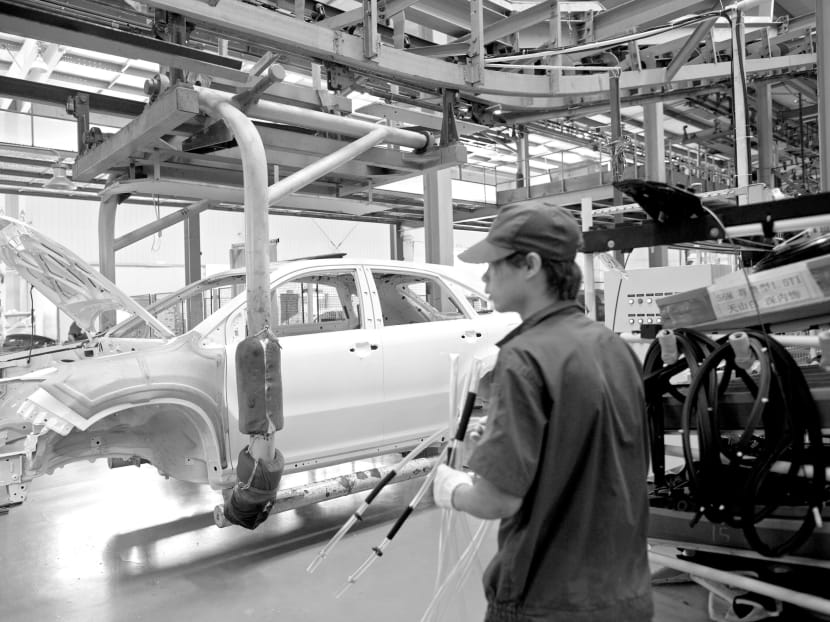China’s distortionary policies perpetuate dysfunctional growth
Most economists have a reason to be worried about China’s economy — whether it be low consumption and large external surpluses, industrial overcapacity, environmental degradation or government interventions such as capital controls or financial repression. What many fail to recognise is that these are merely the symptoms of a single underlying problem: China’s skewed growth model.

Employees work on the frame of a
sport-utility vehicle in Shenzhen. Today, China’s proclivity for industrial production is manifested in large-scale manufacturing and infrastructure projects, encouraged by direct and indirect government subsidies.
Photo: Bloomberg
Most economists have a reason to be worried about China’s economy — whether it be low consumption and large external surpluses, industrial overcapacity, environmental degradation or government interventions such as capital controls or financial repression. What many fail to recognise is that these are merely the symptoms of a single underlying problem: China’s skewed growth model.
That model is, to some extent, a policy-induced construct, the result of a deep-rooted bias towards construction and manufacturing as the leading drivers of economic development. This predilection harkens back to the Great Leap Forward of the 1950s, when scrap metal was melted to meet wildly optimistic steel-production targets, thereby advancing Mao’s dream of rapid industrialisation.
Today, China’s proclivity for industrial production is manifested in large-scale manufacturing and infrastructure projects, encouraged by direct and indirect government subsidies. By boosting investment and generating tax revenue for local governments, this approach has a more immediate positive impact on gross domestic product than efforts to develop the service sector. But the model also carries considerable costs. Indeed, China is now locked in a vicious economic circle, sustained by seemingly unrelated distortionary policies that are, in fact, deeply interconnected, even symbiotic.
One of the most glaring features of this pattern is the disparity between China’s GDP growth, which has averaged nearly 10 per cent annually over the past few decades, and its employment growth, which has amounted to only 1 to 2 per cent annually. Clearly, industrialisation and export expansion alone cannot absorb China’s massive labour force.
The problem is that rapid labour-productivity growth in the industrial sector — more than 10 per cent a year over the past two decades — is reducing the need to hire more workers. The service sector, by contrast, experienced much slower labour-productivity growth (about 5 per cent annually over the same period), meaning that it could be far more effective in generating employment growth. In the United States, about 80 per cent of the total labour force was deployed in the services sector in 2012.
BREAKING THE CYCLE
Another consequence of China’s skewed growth model has been a decline in household income as a share of GDP, from 70 per cent in 1990 to 60 per cent in 2009, whereas in the US, for example, the ratio has remained stable, at around 80 per cent of GDP. In other words, Chinese households are missing out on the benefits of economic growth.
This phenomenon, too, can be blamed largely on distortionary policies. In order to cap the rise in labour costs, wages were suppressed, growing by only 5 per cent annually over the past 20 years, while productivity grew at an annual rate of 8.5 per cent.
Meanwhile, financial repression lowered the cost of capital. In the past decade, the average real (inflation-adjusted) return on deposits has been near zero. With about 80 per cent of Chinese household savings deposited in banks, this implicit tax on savings has had a major economic impact, reinforcing Chinese households’ tendency to save and thus undermining consumption growth and exacerbating global imbalances.
In this way, China’s distortionary policies have helped perpetuate a dysfunctional growth model. Wage suppression, financial repression and an undervalued exchange rate subsidise exports and production, at the expense of households, which are thus compelled to save, weakening domestic demand. In order to achieve growth targets, the government thus must depend on exports and investment — an approach that leads to the accumulation of massive reserves, which subsequently need to be sterilised. Low interest rates help contain the cost of sterilisation at the national level and reduce costs at the firm level — again at the expense of households.
Breaking the cycle will not be easy, but there is no other way to address many of the most pressing problems confronting China’s economy. Indeed, the current growth model is also taking a heavy toll on the environment, with pollution threatening the population’s health, especially in urban areas.
Moreover, the bias towards manufacturing and export industries leads to a severe misallocation of capital. Less efficient industrial sectors have accumulated significant excess capacity, destabilising the entire economy, while more productive, efficient sectors lack access to the resources they need.
Restructuring the economy is perhaps the most urgent — and most difficult — challenge facing China’s leaders today. Given that the current distortions are interlinked, they may need to be addressed simultaneously. China’s gradualist approach may no longer work. PROJECT SYNDICATE
ABOUT THE AUTHOR:
Keyu Jin is an economics lecturer at the London School of Economics.






